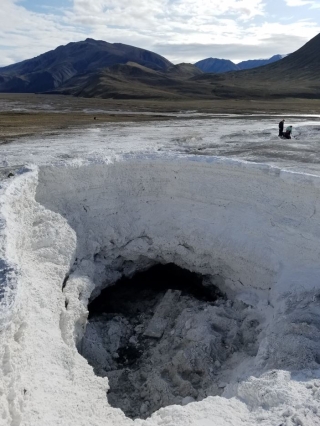Using genomic and single cell microbiology methods, they examined their metabolisms and found that the microbial communities found living in Canada’s High Arctic can survive by eating and breathing simple inorganic compounds of a kind that have been detected on Mars - methane, sulfide, sulfate, carbon monoxide, and carbon dioxide.
Lost Hammer Spring is one of the coldest and saltiest terrestrial springs ever found. The water which travels up through 600 metres of permafrost to the surface is extremely salty (~24% salinity), perennially at sub-zero temperatures (~−5 °C) and contains almost no oxygen (<1ppm dissolved oxygen). The very high salt concentrations keep the Lost Hammer spring from freezing, thus maintaining a liquid water habitat even at sub-zero temperatures.

Image by Elisse Magnuson.
Mars also has areas where widespread salt deposits and possible cold salt springs have been observed. And while earlier studies have found evidence of microbes in this kind of Mars-like environment – this is one of a very few studies to find microbes alive and active.
The researchers used state-of-the-art genomic tools and single cell microbiology methods to identify and characterize a novel, and more importantly, an active microbial community in this spring. Finding the microbes and then sequencing their DNA and mRNA was no easy task - it took years of working with the sediment. The team isolated and sequenced DNA from the spring community, allowing them to reconstruct genomes from approximately 110 microorganisms, most of which have never been seen before. These genomes have allowed the team to determine how such creatures survive and thrive in this unique extreme environment, acted as blueprints for potential life forms in similar environments. Through mRNA sequencing, the team were able to identify active genes in the genomes and essentially identify some very unusual microbes actively metabolizing in the extreme spring environment.
“The microbes we found and described at Lost Hammer Spring are surprising, because, unlike other microorganisms, they don’t depend on organic material or oxygen to live,” says co-author Dr. Lyle Whyte of McGill University. “Instead, they survive by eating and breathing simple inorganic compounds such as methane, sulfides, sulfate, carbon monoxide and carbon dioxide, all of which are found on Mars. They can also fix carbon dioxide and nitrogen gasses from the atmosphere, all of which makes them highly adapted to both surviving and thriving in very extreme environments on Earth and beyond.”
This discovery is so compelling that samples of the Lost Hammer surface sediments were selected by the European Space Agency to test the life detection capabilities of the instruments they plan to use on the next ExoMars Mission.




Comments